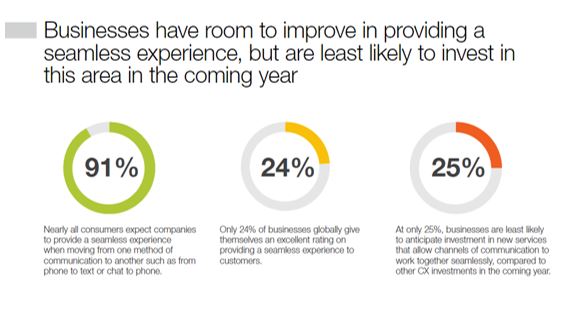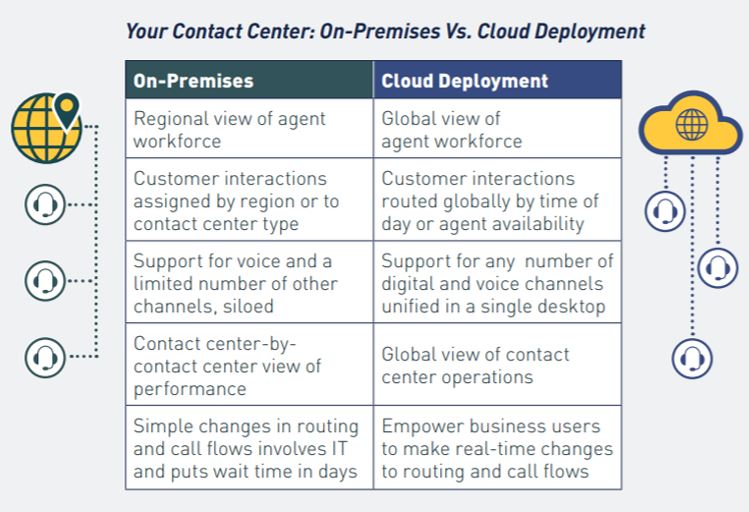Contact center leaders are no longer measured on just efficiency; it is efficiency with better customer experience (CX). Balancing the two is a huge challenge and gets much more complex when you look at contact centers across multiple sites and geographies.
Multiple call center software stacks across sites have shown decreased efficiencies and fragmented experience for customers. When you have global sites, it is not unusual to have different sites having different contact center systems – either because they were bought at different times or driven by different business or IT needs. Whatever the reason, now is a time to look at unifying contact center technology platform, so you can achieve both cost and experience goals. Multiple systems typically lead to a lack of visibility across sites and Business Process Outsourcers (BPO) centers, don’t help you achieve global efficiencies across scheduling or routing or even common processes across sites. Quality processes are not consistent across systems hampering CX.
Moving different systems across sites to one single platform provides a single view of not just your operations but customer experience as well and help you get a holistic view of which center is lacking on what KPIs and where the inconsistencies are to zoom in and fix. Many multi-site systems today are on-premises based and fail to address some of the unique challenges of multi-site environments.
Here are some of the aspects to look at as you think about your multi-site operations.
Improve efficiency
Global multi-site operations definitely provide scale for efficiencies to leverage. Here are some ways to achieve those efficiencies.
Leverage global agents
Multi sites are at an advantage of leveraging their agents across the globe in different time zones. Maybe it is to provide round the clock service or to manage contact volume surge. The larger the pool of agents the greater you can build efficiencies.
Global routing across sites is one of the key aspects to consider and leverage and that has been typically a challenge with on-premises systems. Going hand-in-hand with global routing, is the ability to forecast and schedule across the globe and do better workforce management. These become very critical for multi-site environments.
Get visibility and real-time view across sites
One of the biggest challenges for contact center leaders is getting complete visibility into metrics, queues and reporting not just in one center but visibility across centers. Getting common reporting, analytics helps ensure you get a pulse on every single site as well sites relative to one another. Also, having BPOs in one platform can provide great insights on how to send calls to them without a blind 10% calls to BPOs. Better real-time analytics can help take real-time decisions to balance across sites.
Reduce technology costs
Imagine a tech stack with at least five if not 10 different applications for one contact center and having such unique stacks in 10-15 other sites. It is important to look at a more integrated contact center stack because, it removes the integration hassle and has a single vendor to deal with when it comes to support or implementation. Also, having one stack in every site is definitely going to help with maintenance and upgrade issues instead of 10 different upgrade cycles that pretty much takes away all your IT resources.
While regulations and standards may require you to choose some unique products, overall there should be a large majority of contact center stack to avoid maintenance hassles. And, the same applies to connectivity – imagine the hassle of connectivity across geographies with all local service providers, abiding by all regulations. Getting it done with on premises is going to make this extremely cumbersome and expensive – disaster recovery will be 2X capital investment, upgrades will be long and painful and integrations tough to maintain. The very nature of cloud built on open internet will absolutely accelerate this as well as reduce the costs substantially.
Improve CX
While having a service option for your products across countries is a great opportunity to look at localization, it is also important to establish consistencies of service across sites. Getting that holistic perspective is key. Here are some aspects to consider in a multi-site scenario.
Provide fast service
Fast connection time without long waits is critical for great customer service. Having a global routing through a robust ACD will ensure we get the best resource wherever they sit in any part of the globe, even if they work from home. A system that can provide the ability to do this is critical.
Also, getting a consolidated view of the customer – be it their profile or their billing data or interactions is critical. A truly open platform with an ability to connect to many enterprise applications and bring data to the agent desktop while having a conversation is critical. That will definitely help reduce the time it takes to handle the customer transaction and put the focus on customer rather than searching for data.
Resolve issues the first time
Agent upskilling is critical and more important specially as more complex transactions get routed to agents vs easier one’s going to self-service. One of the challenges for multi-sites is getting a consistent quality across sites. A global platform with clear and consistent ways of call recording, scoring and assessing performance will ensure consistency as well as visibility of skills gap so it gets easier to fix those.
Another aspect to look at is, how to tap into the talent pool and get the best skilled agents. Sometimes the best talent you get is not local and many contact centers have moved to work-from-home model just for this – the ability to get the best talent. A true cloud native platform can help you set up work-from-home in a matter of minutes and have you take calls from anywhere in the world, well evidenced with COVID-19. Also, more intelligent self-service is possible with integration to AI done much easily with an open platform.
Create consistent and seamless experience
Having consistency in service is critical and implementing global blueprints for customer journey is possible with one single platform. Not just that even things like IVR systems can be more standardized so you can see a consistency in experience for your customers across the globe. And, not to forget the hallmark of customer service – the seamless experience across channels. Research commissioned by NICE on CX Benchmark shows that 94% of customers expect a seamless service across channels. Getting a single integrated platform bringing all channels and data across applications in one place is critical for this to become real.
Choose the right platform
Getting the right contact center platform that works for all your centers and helps you achieve both cost and CX goals is definitely an involved process. Based on some of the discussion points, here are some of the key considerations to look at
Get Pre-integrated Suite
While having multiple point solutions in a contact center is one approach to getting best of breed, it quickly becomes expensive and cumbersome to maintain those integrations. Having a suite with all the related contact center applications like omnichannel routing, workforce management, quality management, feedback management, analytics pre integrated and unified will provide faster and easier deployment. Having the right stack and having it pre integrated is the first step.
Leverage cloud
Premise based systems lack a lot of flexibility and agility for deployment and change. Cloud native systems definitely have faster and automatic release cycles, can enable immediate easy work-from-home model and take you out of the hassle of maintaining servers. It brings a new level of agility to move faster and empowers business users to take real-time global routing decisions. As per companies using cloud contact center technology report 18% higher CSAT , compared to those with on-premises contact center technology.
Look for open platform
Integration is crucial to get access to data across systems and provide more insights to everyone – agent, customer and supervisors. An open platform is one which can come with prebuilt integrations or enables effortless customization and integration across your enterprise apps. This becomes especially critical when you think about how you bring in new technologies like AI, ML.
NICE CXone, is an open cloud native platform with unified omnichannel routing, workforce management, analytics and AI provides that customers have leveraged to unify multiple centers.
- Fossil Group turned to NICE CXone to unify its 17 contact centers on a single cloud platform, which continues to provide a host of advantages, from empowered agents to better reporting and performance to increased customer satisfaction.
- With NICE CXone, MoneyGram unified all 11 contact centers on one solution, which boosted agent productivity, simplified maintenance, increased interactions’ quality, and resulted in greater system stability. They also reduced average handle time by 30% and call transfers by 5%.
- Webhelp moved from having 9 different instances of on-premises system that they rationalized to one across 1000 agents in 4 languages.
Learn how larger multi-site contact centers can unify their operations through better processes and technologies and realize both cost and customer experience benefits in this NoJitter white paper.
The transformation to unify your contact center platform across sites is not going to be easy. However, with careful planning and processes, may global multi-site contact centers struggle have established consistencies in operations and customer experience. You can do it too!






